

|
|
|
|
|
|
|
|
|
|
|
|
The plane of Gladsheim,
like that of [Olympus], is a chaotic
plane that is home to a powerful, organized
pantheon of beings--
the Norse gods, who gave this plane and
its layers their commonly
used names. These Norse gods are bound
together in much
the same way as the Olympians, both by
a perma portal (the
Yggdrasil--see the Astral plane) and the
highly dangerous nature <>
of the plane itself. Reality &&
matter begin to break down at
this end of the great wheel, so that realms
often pitch && shift <c>
against each other. By gathering together
into a pantheon, these
Deities gain some control over their gathered
domains.
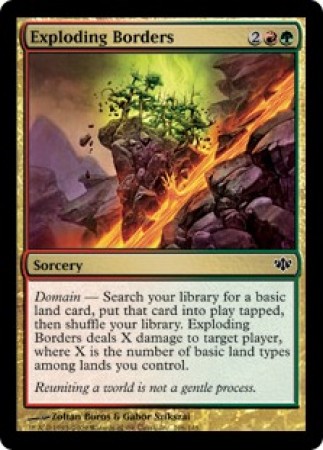
Each layer of Gladsheim
consists of a # of shifting rivers
of earth that form vast arches through
the empty space between
them. These rivers, millions of miles
in width, are in TURN made of
huge chunks of inhabitble earth and other
matter that MOVE and
SHIFT against each other like blocks of
ice in a frozen river. They
grind together then separate again, sometimes
leaving huge
chasms, thousands of miles deep, to the
rivers below. These
earthbergs share the same gravity (same
down direction) and
their upper surfaces are usu. inhabitable.
Their lower sides
emit a radiant fire that illuminates the
lands below. These rivers
flow ponderously, so that chasms open
gradually and mountains
slowly grind ever higher as the earthbergs
push together. When
bergs are grinding against each other,
earthquakes and landslides
are constantly endangering the inhabitants.
Given the continual
radiance from the earthen rivers higher up, the
realms of
the layers of Gladsheim are bathed in a reddish glow.
Deities can modify the shifting of light
and dark to create reasonable days
in their realms. If the Deities can control
weather, they
can cause seasons similar to those of
the PMP.
The huge realm of Asgard has such modifications
to its light and
weather, simulating the effects of northern
Midgard (that is to say
gloomy with strong, harsh winters).
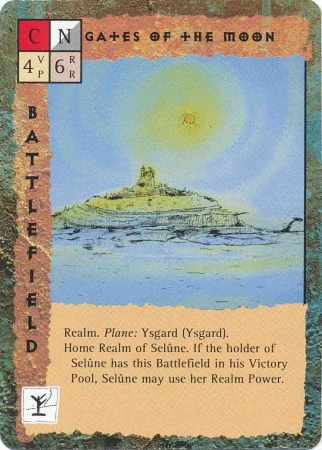
The three layers of Gladsheim are (using
the Norse names)
Asgard, Muspelheim, and Nidavellir.
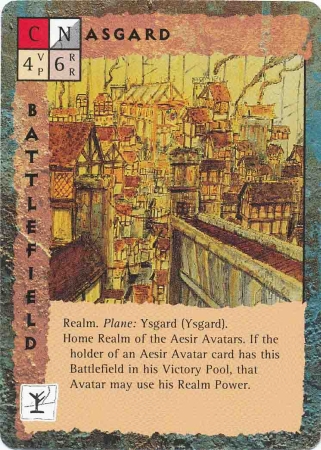
The largest known realm
in the first <(1st)> layer gives the layer its Name. <C>
Asgard is a conglomeration of many smaller
realms and domains of the various gods near the permanent multiplanar portal
that is Yggdrasil (the World Ash).
Each of the domains of these gods is the
size of empires on the Prime plane, so the entire realm spans thousands
of miles.
The related realms of Vanaheim, Alfheim, and Jotenheim are adjacent, and usually in contact with the realm of Asgard.
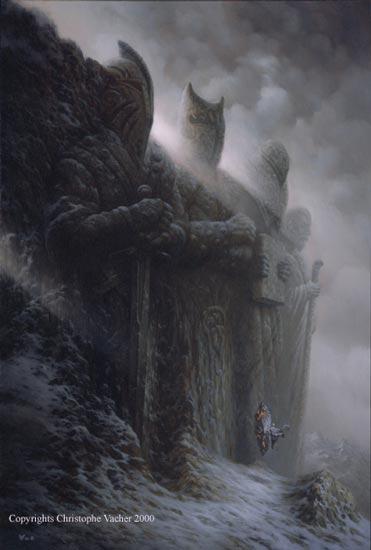
= 3.17 <?>
CG(n)2 = MUSPELHEIM:
Originally thought to have ties to the
plane of elemental Fire,
this layer of Gladsheim
is instead dominated by earthbergs that are
desrever <> in Nature <C> (flaming side
^up^, earth side down).
The fire
giants led by Surtur make this plane their
home in those regions that share barriers
with Asgard and its related realms.
= 2.16

TheearthriversinthislayerofGladsheimaredenselypacked,
<>
so that Nidavellir seems to be a domain
of luminscent && and underground passages.
The terrain shifts here as well, so caverns
and their realms open and close.
Realms
that are reachable on one trip might only
be found by moving
physically through the earth on a later
trip.
= 1.15
Entry to Gladsheim is
accomplished in the standard fashion,
with two important additions. Portals
from the planes of Olympus,
Limbo, and Concordant Opposition are found
in the topmost layer
of Asgard as wells. Those leaving the
plane pass down through
a well; those arriving from the planes
rise from the well and enter
Asgard. The destinations of most wells
are not indicated. Those
that are marked (usu. by incised runes)
have only an 80%
chance of delivering the traveller to
the indicated plane; the other
20% of the time they deliver the traveller
to either of the other two
planes in a random location. Most of the
Norse deities have erected
no protections against viewing portals,
though those viewers
who linger too long in the presence of
Loki
or Odin run the risk of
being yanked into the plane by the irritated
god.
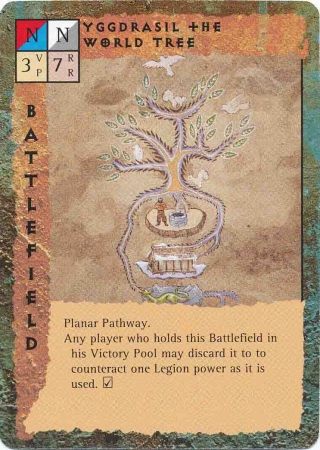
Gladsheim is also the
topmost point of Yggdrasil, the World
Ash. The roots of this mighty tree lie
in the second layer of Hades,
and its branches touch every alternate
PMP
where the Norse pantheon has been or is
being worshiped. It is
conceivable for a traveller to physically
MOVE from the Prime
Material through the Astral and either
to Niflheim or Asgard,
though this journey should take at least
100 days and has never
been successfully attempted. The World
Ash is the home of many
giant stags who browse upon its leaves,
and it also contains
numerous nests of giant eagles. A giant
squirrel named Ratatosk
scales the tree continually, conveying
threats to the eagle and <>
others from the dragons of Niflheim (see
Hades, page 106). <>
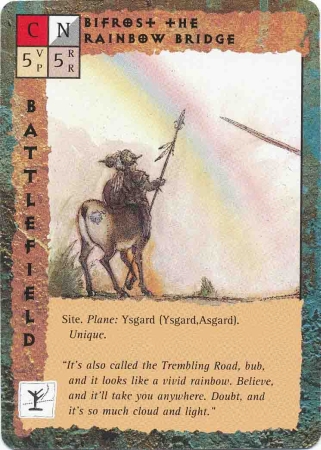
The apertures that the
Yggdrasil causes in the Prime planes
are fixed and limited to those place where
the Norse gods are
known. For this reason, the gods of the
vikings have a second
bridge, which is called Bifrost. Odin
|| Heimdall can direct the
bridge to connect to any PMP, where it
appears
as a {rainbow} leading up to a cloud.
In that cloud is earthly end
of a conduit leading to the entrance of
Asgard, between the plains
of Ida && Vigrid. The bridge is
10 yards wide (it can be made
wider if Odin || Heimdall wishes). While
upon the bridge, all
magickal abilities of beings &&
items are lost (except for those of
Deities && artifacts). While the
bridge can be sent to various
places in the alternate material planes,
its Gladsheim end is
always between the realms
of Ida && Virgrid, under the watchful
eyes of Himinbjorg && Heimdall.
<link>
Spells, magickal items,
and abilities are limited in the plane of
Gladsheim as for any outer plane. A further
limitation applies
while in the Norse realms
|| under the eyes of a Norse Deity. It is
the general belief in this pantheon that
bravery can be proven
through the amount of pain that may be
born, so that beneficial
necromantic spells are generally frowned
on, as only a coward
would accept such help. Such spells do
NOT function in Asgard ||
Vanaheim (those Deities in Jotenheim &&
Alfheim tend to be
more practical on this matter).
Features of Gladsheim
Of all the upper planes,
the plane of Gladsheim is avoided by a
good # of the creatures who usu. make
these places
their home. Only the hollyphant and the
planetar are seen frequently
in these realms.
The plane of Gladsheim does have a
# of remarkable beasts && monsters,
usu. (though NOT
always) of Scandinavian || Germanic origin
(bears, wild boars,
giants, stags, etc.). These creatures
have the same modifications
to their abilities as those of Olympus.
* Subtract 2 from the listed AC.
* Creatures &&
monsters that strike with claws gain a +2
bonus to hit opponents.
* HD are doubled for
purposes of determing HP
and effects of combat.
* One in 20 human-like
creatures (such as the medusae ||
harpies) have some magickal ability (as
a M-U of level 1d10).
It is impossible to
discuss the plane of Gladsheim without
going into detail on the Norse pantheon.
Indeed, this group of
deities has effectively seized control
of the uppermost layer by
forming the most effective organisation
and largest realm around
an established astral-breaching feature,
while at the same time
creating a mechanism (the Bifrost) by
which they can acces new
planes and gain new followers.
This is not to say that
the Norse pantheon is lawful in the same
sense as the pantheon of the hobbits in
the Green Fields. Norse
gods are as petty, selfish, and self-interested
as possible for creatures
so powerful. They are definitely ruled
by the motto of "might
makes right" in the same manner that the
Abyss is ruled. In this
case, might is tempered with godly beneficience
&& compromise.
While Odin is most powerful of the Norse
deities, he is
also aware that if he should fall, Thor
|| Tyr || Loki || any other
god could step into his shoes. The Norse
pantheon is a wild lot.
These gods are not faithful servants acting
at Odin's beck &&
call, despite the claims of Odin's priests.
The layer of Asgard
contains the great realm of the same name,
as well as the adjacent realms
of Alfheim, Jotunheim, and
Vanaheim.
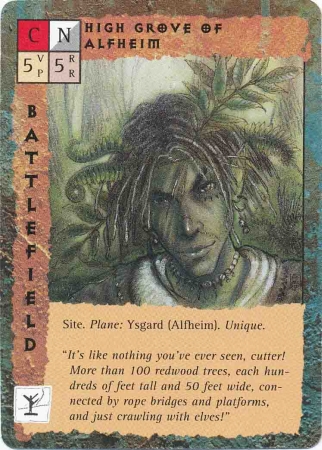
Alfheim is also referred
to as fairyland, the home of those more
chaotic elven spirits who worship Frey
(the ruler of this realm).
These chaotic elves have the same stats
as the einheriar.
Alfheim is a realm
separate from Asgard. There is a
chasm between the 2wo realms
that
is widening by a few inches
per year. This chasm is several miles
deep, but it is still sealed at
its base (there is not yet a hole to the
realms
below). Many of the
portals to Olympus, in particular those
to Arvandor, are located in
Alfheim, and Aerdrie Faenya is a common
visitor here.
The realm
of Vanaheim is the home of the vanir and is similar to
Asgard in terrain, temperament, and inhabitants.
The mixing of
vanir && aesir (Asgardian) blood
and the close line between
their domains almost allows the 2wo to
be considered a single
realm. Like
Asgard, Vanaheim is made up <of> a # of domains
which, if they were separate, could be
considered realms themselves.
Chief among these are Folkvang, where
Freya
makes her home in the shining hall of
Sessrumnir, and Noatun, a
shipyward on the sea on the side away
from Asgard.
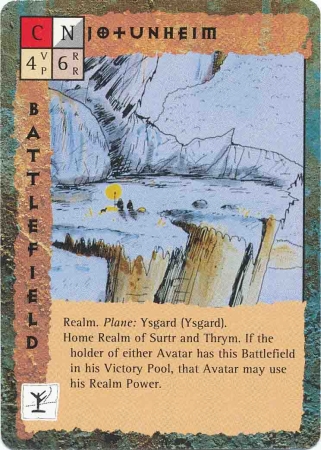
The realm
of Jotenheim, borders both Asgard && Vanaheim. It
is a pile of mountains at the border between
2wo bergs that have
been grinding together. It is officially
separated from Asgard/Vanaheim
by the river Iving, which never freezes
(either because
of an ancient enchantment || underground
heat). Jotenheim's
capitol is Utgard, and it is ruled by
Utgard-Loki, a powerful giant
king with clerical && illusionist
powers. This frigid realm is also
the home of Thyrm, king of the frost giants,
and it is sometimes
the abode of Loki himself. Surtur, whose
home is on the second layer,
Muspelheim, maintains a few outposts of
his followers in
Jotenheim, as the primary barriers between
first and second layers
are in this realm. The well of Mimir is
also found somewhere in
Jotenheim.
The giants
of Gladsheim have the same abilities && powers as
their Prime planar brethren, but they
are smarter than Prime
giants. <One> in every <four> giants
has illusionist powers of up to
14th level, while <one> in 10 is a
M-U (up to 20th level) and
<one> in 20 is a priest (of up to 14th
level.) In +addition+, these creatures
often carry giant-sized magickal items.
Equip any party of giants
w/ magickal items as if they were a party
of adventurers of the
given levels. <link here to DMG.C>
Illusions created by these giants can affect the gods
themselves, though they can never
bring about the death of a
Greater Deity in his home plane.
The realm
of Asgard is the largest realm
of its layer and is made
up of many smaller domains.
* The highest peak of
Asgard has been levelled off, for USE as
the feast-hall (though not home) of Odin,
also called Gladsheim ||
Mount Joy. It is this Gladsheim that gives
the plane its name.
This is the feast-hall of the aesir &&
vanir, the palce where fealty
to Odin is sworn && great feasts
held.
* The Odinhome (Valaskialf),
where the Father of the Norse
Deities sits upon his all-seeing throne
of Hlidskialf, is located
several leaguesfrom the Odinhall of Gladsheim.
* Thor makes his abode
in Thrudheim, in the oak and iron-shod
palace called Bilskirnir, where even the
thralls who serve
the palace are joyous in their work. Thor's
wife, Sif, dwells here
w/ Him.
* Frigga, wife of Odin,
makes her home in the palace Fensalir
in the domain of Vingolf, which is adjacent
to that of her husband's hall.
* Balder's domain &&
palace are both known as Breidablik.
This domain is said to be one of the most
beautiful of the realms
that make up Asgard.
* Himinbjorg is the
citadel of Heimdall, watcher of the Bifrost,
and is located where that bridge ends
upon the plains of Ida &&
Vigrid. Himinbjorg is a strong redoubt
clad in plates of mirrored
steel, manned by both einheriar and, in
times of need, valkyries.
* Uller keeps a damp
realm in in Ydalir, best known for it groves
of yew trees. From these trees he makes
bows of the finest godly
quality.
* Vidi, also called
Landvidi, is a region of tall grass && young
saplings. Here Vidar, a son of Odin, keeps
his house && stables.
* The steel &&
silver palace of Glitnir lends its name to
Forseti's
domain. It is here that the god of justice
rules in cases
where Odin cannot || will NOT. Forseti
is a lawful Norse deity, yet
his presence is recognized by the remainder
of the pantheon as a
necessity for their survival as a group.
* Loki maintains several
small houses in the realm
of Asgard,
as well as bolt-holes both in Jotenheim
and in Pandemonium for
refuge when he has angered his fellow
Deities beyond measure.
* Idun maintains a simple
house in her orchards where she
tends her apples. Her husband, Bragi,
makes his abode in far
Elysium. Neither has yet consented to
MOVE to the other's realm
permanently (though they often visit each
other).
* The lesser Norse deities
tend to wander or to maintain
smaller estates on the domains of others.
Aegir can be encountered
in Vanaheim, Asgard, and Jotenheim, for
he is a lesser relative
of the giants. Magni && Modi,
the sons of Thor, reside in
Thrudheim when NOT adventuring on their
own. Tyr, while no
lesser god, makes his abode in Valhalla.
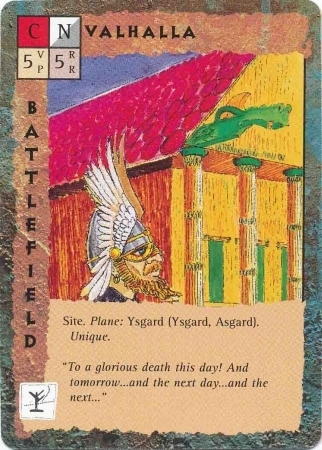
Of great importance
amongst the domains of the realm Asgard
is Valhalla, home of the einheriar &&
the valkyries. The hall of
Valhalla is vast, its roof thatched with
shields and its pillars great
collections of spears, but the land for
leagues around is dominated
by smaller halls where various einheriar
make their homes.
The einheriar
of Asgard are primarily males.
Einheriar of Gladsheim
are not affected by fear or other
emotion-affecting spells, nor are they
subject to normal illusion ||
phantasm magick (see the note
on giants, page 96). The einheriar
are the spirits of chaotic warriors. They
cannot die fully in the
plane: if killed here, they return to
life in Valhalla on the next
daybreak.
While the Norse pantheon
is generally accepted as the
dominant group of gods in this plane,
they are by no means the only
Deities here. Unlike the Olympians, the
aesir && vanir do NOT
have to share their layer with another
group of powerful beings,
but there are other inhabitants of this
plane that occasionally vex
the Norse deities.
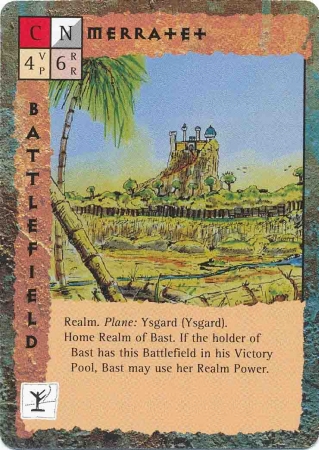
On the far side of the
great ocean that borders Vanir is the
realm of
Bast, the cat-goddess of the Egyptians,
who makes her
dwelling in a huge vine-covered
acropolis on the edge of wasting
desert. Bast and those spirits that serve
her are fond of parties,
festivals, and masques; there is always
some celebration going on
within her halls. Bast's realm
has served as a hiding place for
various Norse deities from time to time,
incl. Loki and Bragi.
She claims dominion over all catkind,
but this claim is contested
by the Cat Lord of the Beastlands. <cat
lady?>
Lakshmi
of the Indian mythos is the goddess of fortune && beauty.
It is to her good fortune that her domain
is far from that of
the Norse pantheon so that the rowdy deities
that dwell within
Asgard cannot disturb the thoughts of
the wife of Vishnu. Her
domain is said to be a great step-temple
that is overgrown with
lotus flowers that are always in bloom.
Three demi-gods, 2wo
of the Japanese mythos and one of the
Indian, make their abodes on bits of flying
rock that they steer
between the great
rivers of earth where where most of the more powerful
gods make their domains. They sometimes
wander over &&
into the realms
of other deities. The Indian demi-god is Karttikeya,
whose palace is a temple on an island
in a lake of white
(drinkable) milk that is itself surrounded
by an island floating
through Gladsheim. The Japanese demi-gods
are Hachiman
(whose portfolio is war) and Oh-Kuni-Nushi,
who is both patron to
heroes and the master of land &&
earth.